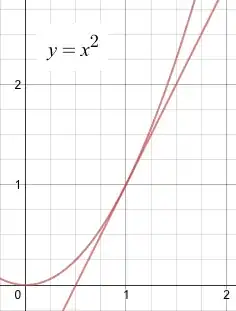Instantaneous Rate of Change at a Point, not over an Interval
You can describe rate of change without any interval at all, at a specific point. In fact, to try and involve an interval, even a very small one, is somewhat counter to the concept. If you involve an interval in describing a rate of change, then you would be talking about an average rate of change. For example, when people describe the velocity(rate of position change) of a vehicle over an interval of 100ft, then you would usually be talking about the average speed, assuming it wasn't constant over the entire interval.
Therefore, a rate of change is always instantaneous. You can identify any point, which has no length/interval, and say what the rate of change at that point is. Instantaneous rate of change is analogous to a point.
This also helps understand why certain points have an undefined rate of change, and why the "ever smaller interval" concept is somewhat misleading.

If you tried to use the very very tiny interval concept to identify the rate of change across point p and point q by sampling a point just to the left and right of p to define an interval, then you'd see a very large change. Perhaps point p is at x coordinate 1.00, and we define an interval from .99 to 1.01 and sample values of .99,2 and 1.01,10. This would be a rate of change of 400 y per x. If you make your interval smaller and smaller, your rate of change appears to approach infinity, which again is very misleading, because the instantaneous rate of change at p is undefined.
I'm not trying to disregard the intervals concept as useless, but to emphasize that very small intervals are a concept that can't be applied rigorously. They certainly help understand the concept of a derivatives, because if you were to imagine that you don't know what the instantaneous rate of change at a particular point is, then you'd have to observe how much change occurred over an interval in order to estimate the rate of change. It helps to understand how these functions were "designed".
There is no observed change, but we know the RATE of change
Let's take instantaneous speed, for example. If it's truly
instantaneous, then there is no change in x (time), since there's no
time interval'
You are absolutely right! There is no change in position as there is no defined interval. However, at a specific point, we can still describe what the instantaneous rate of change is, which is a way of saying how much it will change if an interval were defined. Imagine we freeze a frame of a movie where someone tells you a bullet just exited a barrel at an instantaneous velocity of 300 meters/s. That's not hard to understand right? If someone asked, disregarding air resistance and gravity, where will that bullet be two seconds from then? Now you've introduced an interval, and using two things, the initial position, and the instantaneous rate of change at that position, you can confidently draw a line along the bullet's trajectory and conclude it will be 600 meters away in that two seconds. Based on that instantaneous information, we can model for any interval how that bullet's position will change. We can apply the instantaneous velocity across the entire interval only because we assumed it was constant across the interval.
Where calculus comes to the rescue is that we often deal with non-constant rates of change. We know in reality that the bullet will slow down due to air resistance A(), and it's trajectory will be an arc instead of straight line due to the constant acceleration of gravity G() (which results in a non-constant velocity). If we have functions that describe air resistance and gravity's influence on our velocity, then we can describe the non-constant instantaneous velocities over any point on the entire interval. Since those are instantaneous points and are non-constant, they are somewhat useless. We could use the "very small interval" approach of sampling changes in position to sum up across the entire interval, but since the velocity is constantly changing, we'd be accumulating alot of error. E.g. if the initial velocity is 300 m/s but slows to 250 m/s after half a second, then how far did the bullet travel in half a second? You could try to average, but that assumes linear change in speed which might not be the case. Just about any iterative approach you take that involves small intervals will introduce error. However, with the help of calculus we can directly and accurately incorporate the influence of A() and G() on our non-constant velocity to directly calculate the change in position.
More than just a Concept
In addition to being an aid in understanding concepts, the "very small interval" concept is often applied in computational models where direct methods are not feasible, perhaps because a computer algorithm cannot determine a direct method. This is exactly how physics are simulated in many computer games. Each iteration it may know that .03 seconds has passed, and based on various rates of changes(usually determined based first on what forces are in affect) it will determine what has changed across that interval. In certain situations this can be extremely inaccurate, but in other cases with small enough intervals it may be sufficiently accurate to meet desired requirements.

